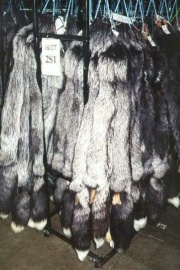Difference between pages "Silver cyanide" and "Silver fox"
(Difference between pages)
Jump to navigation
Jump to search
| Line 1: | Line 1: | ||
| + | [[File:Silberfuchs_06.jpg|thumb|Silver fox]] | ||
== Description == | == Description == | ||
| − | + | A color variation of the [[red fox]] (''Vulpes vulpes'' or ''Vulpes fulva'') found in North America. The silver fox is a blue-black color with silver-tipped hairs. Their [[fur|fur]] is fine and dense with long, silky guard hairs. Silver fox pelts are the most valued of the many types of fox fur and many breeding farms exist for their production. Fox pelts have been used for trim, capes, collars, and cuffs. | |
| − | == | + | [[File:silverfox.jpg|thumb|Silver fox pelts]] |
| + | == Synonyms and Related Terms == | ||
| − | + | ''Vulpes vulpe''s; ''Vulpes fulva''; platinum fox; Reynard the fox | |
| − | |||
==Physical and Chemical Properties== | ==Physical and Chemical Properties== | ||
| − | + | Color variants include very light grey to black with some shade of brown or red. Within each hair, the lower 60% (closest to the root); is black, white is in the middle and the tip is again black. | |
| − | + | == Additional Images == | |
| − | |||
| − | |||
| − | |||
| − | |||
| − | |||
| − | |||
| − | |||
| − | |||
| − | |||
| − | |||
| − | |||
| − | |||
| − | |||
| − | |||
| − | |||
| − | |||
| − | |||
| − | |||
| − | |||
| + | <gallery> | ||
| + | File:silverfox2large.jpg|Silver fox hair | ||
| + | File:silverfox1large.jpg|Silver fox hair | ||
| + | </gallery> | ||
==Resources and Citations== | ==Resources and Citations== | ||
| − | * | + | * ''Encyclopedia Britannica'', http://www.britannica.com Comment: "fox" [Accessed November 15, 2001]. |
| − | * | + | * Edward Reich, Carlton J. Siegler, ''Consumer Goods: How to Know and Use Them'', American Book Company, New York City, 1937 |
| − | |||
| − | |||
| − | |||
| − | |||
[[Category:Materials database]] | [[Category:Materials database]] | ||
Latest revision as of 10:38, 31 May 2022
Description
A color variation of the Red fox (Vulpes vulpes or Vulpes fulva) found in North America. The silver fox is a blue-black color with silver-tipped hairs. Their Fur is fine and dense with long, silky guard hairs. Silver fox pelts are the most valued of the many types of fox fur and many breeding farms exist for their production. Fox pelts have been used for trim, capes, collars, and cuffs.
Synonyms and Related Terms
Vulpes vulpes; Vulpes fulva; platinum fox; Reynard the fox
Physical and Chemical Properties
Color variants include very light grey to black with some shade of brown or red. Within each hair, the lower 60% (closest to the root); is black, white is in the middle and the tip is again black.
Additional Images
Resources and Citations
- Encyclopedia Britannica, http://www.britannica.com Comment: "fox" [Accessed November 15, 2001].
- Edward Reich, Carlton J. Siegler, Consumer Goods: How to Know and Use Them, American Book Company, New York City, 1937



